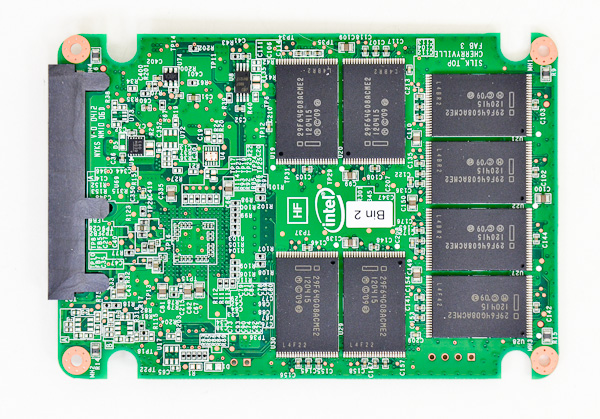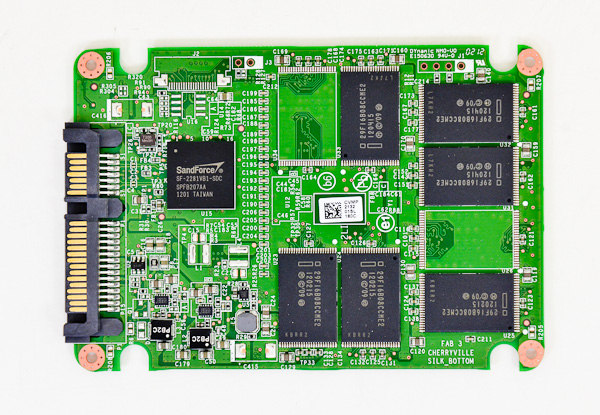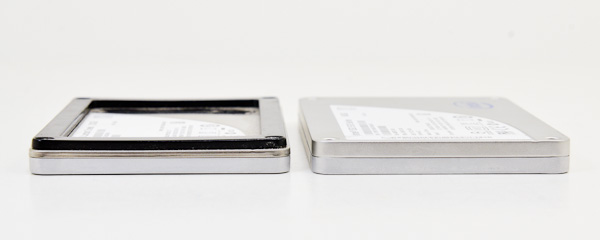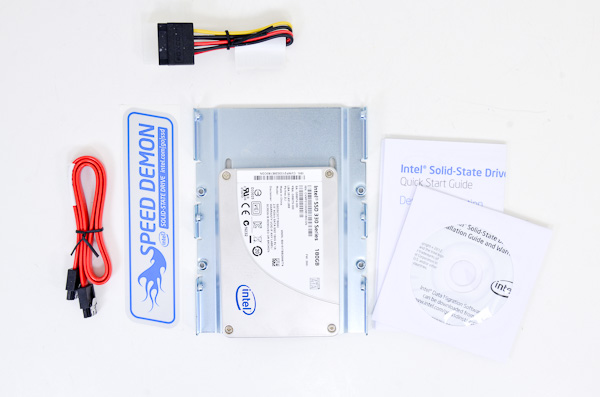The Intel SSD 330 Review (60GB, 120GB, 180GB)
by Anand Lal Shimpi on August 1, 2012 12:01 AM ESTThe Drives and Internal Architecture
The SF-2281 controller features eight NAND channels, although it can pipeline multiple requests on each channel. The 60GB and 120GB drives both feature eight NAND packages with one 8GB die and two 8GB die per package, respectively. That works out to be 64GiB of NAND on the 60GB drive, and 128GiB of NAND on the 120GB drive. RAISE is disabled on both of these drives, all spare area is dedicated for the replacement of bad blocks as well as garbage collection/block recycling.

Intel's SSD 330 60GB, all NAND appears on one side of the PCB
The 180GB drive on the other hand uses twelve NAND packages, with two 8GB 25nm MLC die per package. The math works out to be 192GiB of NAND. SandForce's redundant NAND technology (RAISE) is enabled on the 180GB drive, so the extra spare area is divided between NAND failure coverage as well as traditional garbage collection/bad block replacement. Note the non-multiple-of-eight NAND configuration poses a bit of a challenge for extracting peak performance out of the drive, however it's still able to deliver a tangible advantage over the 120GB version. It's possible that Intel still routes all 8 channels to NAND die and simply sacrifices pipelining of requests on some of the channels.

Intel's 180GB SSD 330 features twelve NAND packages (6 on each side)
In the case of all of the Intel SSD 330 models, the SF-2281 controller is cooled by a thermal pad that helps dissipate heat across the SSD's metal chassis. All 330s are 9.5mm thick without any external removable spacer, which sets these drives apart from most Intel SSDs. Strangely enough, the plastic spacer that's normally on the outside of the drive is actually located on the inside of the 330, although it's not actually responsible for the thicker form factor. I'm not sure why, but it's in there.

Typical 9.5mm Intel SSD (left) vs. 9.5mm Intel SSD 330 (right)
The Bundle
The standard 330 bundle comes with a molex to SATA power adapter, a SATA cable, a 2.5" to 3.5" drive sled and a link to download Intel's Data Migration Software (powered by Acronis).
As the 330 isn't targeted at OEMs, I'm not sure if we'll see standalone drives sold without the bundle. As of now this is the only way to get the 330.












64 Comments
View All Comments
Oxford Guy - Wednesday, August 1, 2012 - link
Yeah, the old version of the software detected the drive as being a 500 series.This looks like a bug to me.
A5 - Wednesday, August 1, 2012 - link
The next paragraph of the article shows that the latest SSD Toolbox properly detects the drive. It's safe to assume that that is what Anand used for testing.chrnochime - Wednesday, August 1, 2012 - link
I heard about the 8mb problem with intel 320 SSDs. Is that still problem with these new SF based SSDs?Per Hansson - Wednesday, August 1, 2012 - link
That problem is only with Intel's own controller, not Sandforce so this drive and the 520 should be fine...marioyohanes - Wednesday, August 1, 2012 - link
I have one of this SSD installed on my 2011 Mac, and it doesn't work well with sleep and also always caused major crash after software update (like any other SF 22xx SSD). Then my friend who recently bought HP Envy also got this SSD by default from HP, guess what, screen goes black after sleep (not all the time, but most of the time), crashed after 1 month he had to reinstalled the entire thing and lost his data. Now, after 6 months and after 5 times RMA, he ended up reformatting his drive every month.I just wish Anand more honest by telling people the truth about SSD, specially SF based controller, because after trying more than 5 SF based SSD, I can say they're sucks! buy it only if you're planning to reformat your drive every now and then. Good for benchmark score, but not for daily use. Contest only probably. However, my Intel 320 and Crucial M4 stays reliable even after years of heavy use.
Oxford Guy - Wednesday, August 1, 2012 - link
I, and two colleagues, have 240 GB Sandforce drives (1x Vertex 2, 2x Chronos DX). None of them have given us any problems. I'm using mine in a 2008 Macbook Pro and they are using theirs in 2011 Macbook Pros. All of us have TRIM enabled.Did you make sure to update the firmware to the latest version before using the drive in your Mac?
Also, older versions of OS X should have the feature disabled that copies the contents of RAM to disk when the machine is put to sleep.
angelsmaster - Tuesday, September 4, 2012 - link
hi, i just bought yesterday this intel 330 series, and i am also using mac 2011, haven't updated yet cause i could not find the firmware ware update for this 240 gb, i could only find are for 60 ~ 180 gig firmware update, i tried downloading and its error due to .exe . and the TRIM is not supported.. and idea on this? thank!eviloz_i - Wednesday, August 1, 2012 - link
i have a 320 drive (120gb) a 520 drive (60gb) and a 330 (60gb), the first two on intel mb, third on asus mball installed directly with windows7 x64 without any ssd-specific procedure in the bios or in the os (just for paranoia, checked if trim was enabled after install. it was)
they all perform flawlessly, all pc regularly jump in an out of both turn-off-video screen saver and suspend.
I never benchmarked them, i dont need astral performance, but they are fast.
murakozi - Wednesday, August 1, 2012 - link
Swapped out all HDD-s in our office and home computers (that is: HP 6910p, HP NC 6400, HP TC 4400, 2 x Dell Optiplex 790 DT, Dell Optiplex 755 DT, HP XW8400) without issues. OS variety: XP Prof, Vista Prof SP2, Win7 Prof).Works like a charm, any time. The only product I ever had problems with was Seagate Momentus XT 500 GB, which - even after several installs and OS-es - produced corrupted blocks and r/w failures within days.
IMHO the SSD products have matured enough to use them in "mission critical" enviroments (I have them also in our office server, the old box literally flies...)
Ammaross - Thursday, August 2, 2012 - link
I've rolled out 10 identical workstations, each outfitted with a 60GB Intel 330 drive, all running the same Win7 image. Of those 10, 1 immediately started giving us problems. The OS would "stutter," locking up for seconds at a time. I narrowed it down to the SATA link power management features of Windows. Apparently, these drives still have issues when their SATA link is put into idle/low power modes. Replaced the drive with a Vertex 3 and all was well.